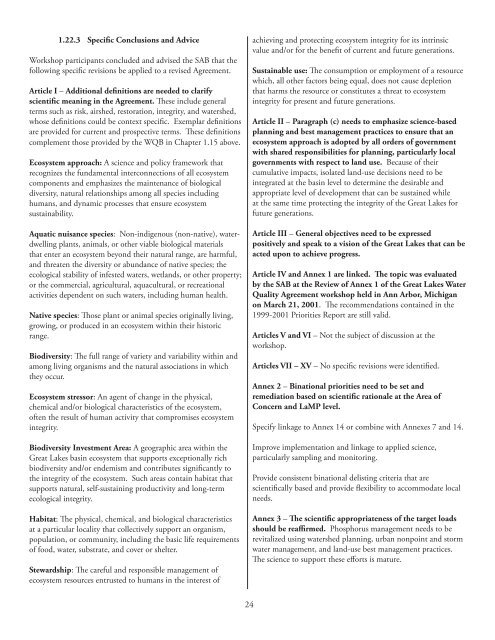Principles for Review of the Great Lakes Water Quality Agreement
Principles for Review of the Great Lakes Water Quality Agreement
Principles for Review of the Great Lakes Water Quality Agreement
Create successful ePaper yourself
Turn your PDF publications into a flip-book with our unique Google optimized e-Paper software.
1.22.3 Specific Conclusions and Advice<br />
Workshop participants concluded and advised <strong>the</strong> SAB that <strong>the</strong><br />
following specific revisions be applied to a revised <strong>Agreement</strong>.<br />
Article I – Additional definitions are needed to clarify<br />
scientific meaning in <strong>the</strong> <strong>Agreement</strong>. These include general<br />
terms such as risk, airshed, restoration, integrity, and watershed,<br />
whose definitions could be context specific. Exemplar definitions<br />
are provided <strong>for</strong> current and prospective terms. These definitions<br />
complement those provided by <strong>the</strong> WQB in Chapter 1.15 above.<br />
Ecosystem approach: A science and policy framework that<br />
recognizes <strong>the</strong> fundamental interconnections <strong>of</strong> all ecosystem<br />
components and emphasizes <strong>the</strong> maintenance <strong>of</strong> biological<br />
diversity, natural relationships among all species including<br />
humans, and dynamic processes that ensure ecosystem<br />
sustainability.<br />
Aquatic nuisance species: Non-indigenous (non-native), waterdwelling<br />
plants, animals, or o<strong>the</strong>r viable biological materials<br />
that enter an ecosystem beyond <strong>the</strong>ir natural range, are harmful,<br />
and threaten <strong>the</strong> diversity or abundance <strong>of</strong> native species; <strong>the</strong><br />
ecological stability <strong>of</strong> infested waters, wetlands, or o<strong>the</strong>r property;<br />
or <strong>the</strong> commercial, agricultural, aquacultural, or recreational<br />
activities dependent on such waters, including human health.<br />
Native species: Those plant or animal species originally living,<br />
growing, or produced in an ecosystem within <strong>the</strong>ir historic<br />
range.<br />
Biodiversity: The full range <strong>of</strong> variety and variability within and<br />
among living organisms and <strong>the</strong> natural associations in which<br />
<strong>the</strong>y occur.<br />
Ecosystem stressor: An agent <strong>of</strong> change in <strong>the</strong> physical,<br />
chemical and/or biological characteristics <strong>of</strong> <strong>the</strong> ecosystem,<br />
<strong>of</strong>ten <strong>the</strong> result <strong>of</strong> human activity that compromises ecosystem<br />
integrity.<br />
Biodiversity Investment Area: A geographic area within <strong>the</strong><br />
<strong>Great</strong> <strong>Lakes</strong> basin ecosystem that supports exceptionally rich<br />
biodiversity and/or endemism and contributes significantly to<br />
<strong>the</strong> integrity <strong>of</strong> <strong>the</strong> ecosystem. Such areas contain habitat that<br />
supports natural, self-sustaining productivity and long-term<br />
ecological integrity.<br />
Habitat: The physical, chemical, and biological characteristics<br />
at a particular locality that collectively support an organism,<br />
population, or community, including <strong>the</strong> basic life requirements<br />
<strong>of</strong> food, water, substrate, and cover or shelter.<br />
Stewardship: The careful and responsible management <strong>of</strong><br />
ecosystem resources entrusted to humans in <strong>the</strong> interest <strong>of</strong><br />
achieving and protecting ecosystem integrity <strong>for</strong> its intrinsic<br />
value and/or <strong>for</strong> <strong>the</strong> benefit <strong>of</strong> current and future generations.<br />
Sustainable use: The consumption or employment <strong>of</strong> a resource<br />
which, all o<strong>the</strong>r factors being equal, does not cause depletion<br />
that harms <strong>the</strong> resource or constitutes a threat to ecosystem<br />
integrity <strong>for</strong> present and future generations.<br />
Article II – Paragraph (c) needs to emphasize science-based<br />
planning and best management practices to ensure that an<br />
ecosystem approach is adopted by all orders <strong>of</strong> government<br />
with shared responsibilities <strong>for</strong> planning, particularly local<br />
governments with respect to land use. Because <strong>of</strong> <strong>the</strong>ir<br />
cumulative impacts, isolated land-use decisions need to be<br />
integrated at <strong>the</strong> basin level to determine <strong>the</strong> desirable and<br />
appropriate level <strong>of</strong> development that can be sustained while<br />
at <strong>the</strong> same time protecting <strong>the</strong> integrity <strong>of</strong> <strong>the</strong> <strong>Great</strong> <strong>Lakes</strong> <strong>for</strong><br />
future generations.<br />
Article III – General objectives need to be expressed<br />
positively and speak to a vision <strong>of</strong> <strong>the</strong> <strong>Great</strong> <strong>Lakes</strong> that can be<br />
acted upon to achieve progress.<br />
Article IV and Annex 1 are linked. The topic was evaluated<br />
by <strong>the</strong> SAB at <strong>the</strong> <strong>Review</strong> <strong>of</strong> Annex 1 <strong>of</strong> <strong>the</strong> <strong>Great</strong> <strong>Lakes</strong> <strong>Water</strong><br />
<strong>Quality</strong> <strong>Agreement</strong> workshop held in Ann Arbor, Michigan<br />
on March 21, 2001. The recommendations contained in <strong>the</strong><br />
1999-2001 Priorities Report are still valid.<br />
Articles V and VI – Not <strong>the</strong> subject <strong>of</strong> discussion at <strong>the</strong><br />
workshop.<br />
Articles VII – XV – No specific revisions were identified.<br />
Annex 2 – Binational priorities need to be set and<br />
remediation based on scientific rationale at <strong>the</strong> Area <strong>of</strong><br />
Concern and LaMP level.<br />
Specify linkage to Annex 14 or combine with Annexes 7 and 14.<br />
Improve implementation and linkage to applied science,<br />
particularly sampling and monitoring.<br />
Provide consistent binational delisting criteria that are<br />
scientifically based and provide flexibility to accommodate local<br />
needs.<br />
Annex 3 – The scientific appropriateness <strong>of</strong> <strong>the</strong> target loads<br />
should be reaffirmed. Phosphorus management needs to be<br />
revitalized using watershed planning, urban nonpoint and storm<br />
water management, and land-use best management practices.<br />
The science to support <strong>the</strong>se ef<strong>for</strong>ts is mature.<br />
24

















